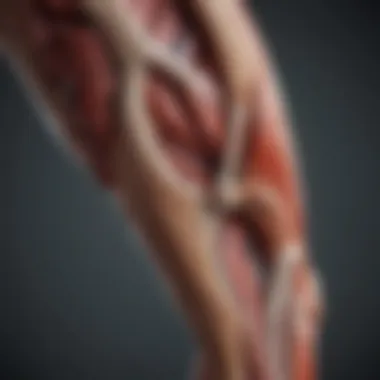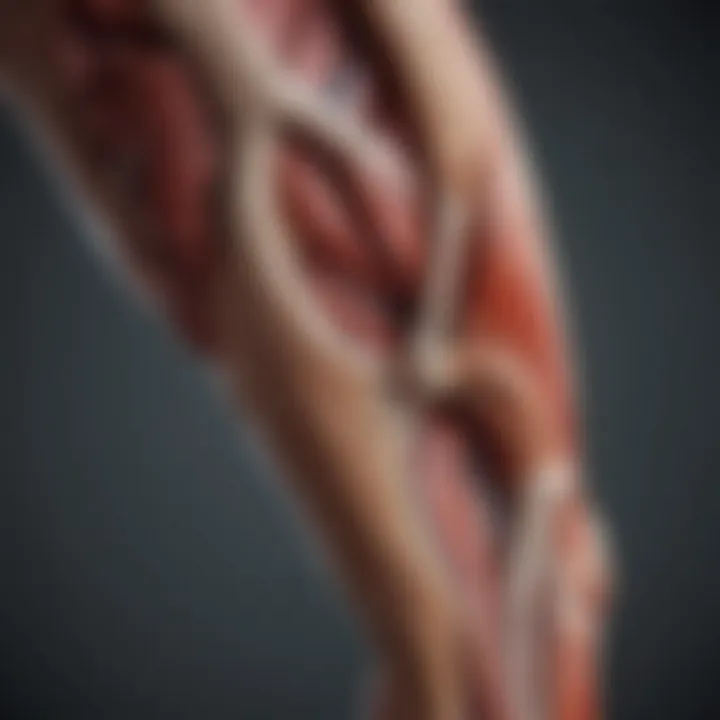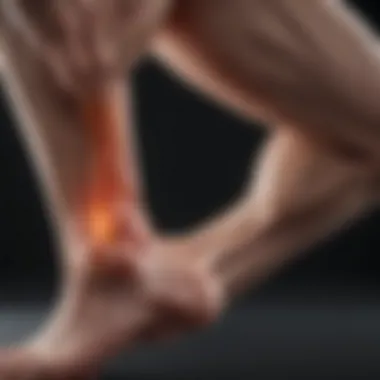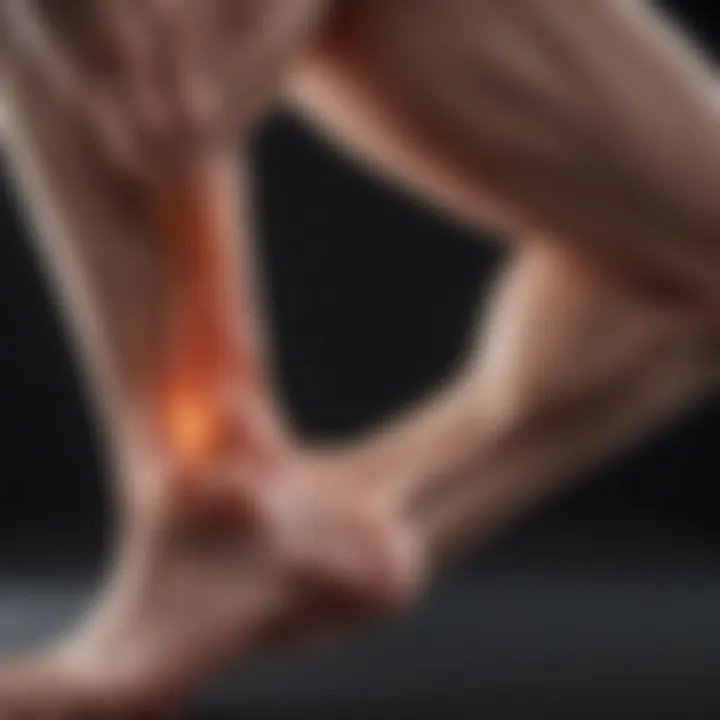Understanding Leg and Foot Muscle Spasms in Depth


Intro
Leg and foot muscle spasms are not often given the spotlight they deserve, yet they can impact daily life in ways that are hard to ignore. These involuntary contractions may feel like a tightening rope in the calf or a sudden cramp in the arch of the foot, bringing with them discomfort and frustration. For some, these spasms are mere annoyances that come and go. For others, especially if they're chronic, they can lead to significant distress and loss of mobility.
In understanding this phenomenon, it's essential to peel back layers of complexity, recognizing both the physical and psychological nuances involved. Factors ranging from dehydration to stress, and the intricacies of muscle physiology can all contribute to the frequency and intensity of these spasms.
For students, researchers, and healthcare professionals alike, grasping the full scope of leg and foot muscle spasms can illuminate prevention strategies as well as effective treatment options. This guide aims to serve as a comprehensive overview, merging established knowledge with fresh insights drawn from ongoing research and expert opinions.
Research Context
Background and Rationale
Understanding the triggers and implications of muscle spasms becomes more crucial when we consider the potential for these contractions to disrupt day-to-day activities or affect athletic performance. As muscle health is directly linked to overall physical functioning, comprehending spasms can help in forming effective intervention strategies.
Beyond the individual experience lies a broader societal concern. With increasing numbers of individuals engaging in activities that require extended periods of sitting or standing - often without adequate hydration or rest - knowledge of spasms is crucial for recognizing and mitigating the risk factors involved. It’s not just about treating pain; it's about empowering individuals to take control of their muscle wellness.
Literature Review
A thorough literature search reveals that the prevalence of muscle spasms is widely documented. For instance, studies indicate that athletes are among the most affected, yet the condition also affects the elderly, pregnant women, and individuals with specific medical conditions such as diabetes or peripheral artery disease.
Key findings from various studies highlight common risk factors, including nutrient deficiencies—particularly magnesium and potassium—as well as overexertion during exercise. Other literature emphasizes the role of stress, sleep deprivation, and prolonged immobilization as contributing elements to leg and foot muscle cramps.
As such, these insights not only enrich our understanding but also aid in constructing a holistic view that highlights the multifaceted nature of muscle spasms.
"Knowledge is power; understanding your body's signals can lead to more effective management of discomfort and pain that may arise from muscle spasms."
Research continues to evolve, focusing on both symptomatic relief and exploration of preventive measures that can be tailored to individual circumstances. This evolving narrative lays the groundwork for a comprehensive examination of the characteristics and management strategies pertaining to leg and foot muscle spasms.
Preamble to Muscle Spasms
Muscle spasms, those involuntary contractions that can strike without warning, serve as an important topic worth understanding. Particularly in the legs and feet, these spasms can cause significant discomfort and can disrupt the daily routines of those impacted. By diving deep into the nature of these episodes, one can not only grasp why they occur but also how to effectively manage and mitigate their effects.
Definition of Muscle Spasms
To put it plainly, muscle spasms are sudden, involuntary contractions of one or more muscles. They can happen to anyone at any age and arise in various places throughout the body. However, when it comes to the legs and feet, the experience can be particularly jarring. Imagine feeling your calf tighten up or your toes curl in agony for what seems like an eternity. Those episodes are often characterized by intense pain, and in many cases, a lingering soreness can follow. Understanding the physiological basis behind these spasms allows healthcare providers and individuals alike to develop targeted approaches toward both prevention and treatment.
Prevalence of Leg and Foot Muscle Spasms
The occurrence of leg and foot muscle spasms is more common than one might think. Research indicates that as much as 60% of adults will experience spasms at some point in their lives. These episodes can range from a mild nuisance to a serious impediment, impacting activities such as walking, exercising, or even sleeping.
- Factors influencing prevalence include:
- Age: Older individuals tend to report a higher incidence.
- Physical activity levels: Athletes, particularly those engaging in endurance sports, face greater risks.
- Hydration status: Dehydrated individuals are more prone.
The frequency of spasms can vary widely, from sporadic occurrences to frequent episodes that disrupt quality of life. So, keeping an eye on both symptoms and triggers can be instrumental in addressing this issue. Not only does understanding prevalence shed light on the issue, but it also underlines the necessity for effective management strategies across various demographics.
Physiological Mechanisms of Muscle Spasms
Understanding the physiological mechanisms underlying muscle spasms is crucial for anyone looking to grapple with this often bothersome condition. It is not merely a matter of discomfort; recognizing how muscle spasms develop can illuminate pathways for intervention and prevention. By dissecting elements such as neuromuscular activity, electrolyte imbalances, and muscle fatigue, we can better appreciate why these spasms occur and how to manage them effectively.
Neuromuscular Activity
At the core of muscle spasms lies the neuromuscular system, the intricate network connecting the brain to the muscles through nerves. This system governs how muscle fibers contract and relax. When a spasm happens, it's typically due to some form of disruption in this communication.
This disruption can arise from various factors:
- Overexertion: Strenuous activities can irritate the nerves responsible for muscle control, causing excessive signaling.
- Heavy Lifting: Lifting beyond one's capacity can lead to sudden contractions as muscles struggle to cope with the stress.
- Nerve Injury: Damage to the nerves might prompt inappropriate signals, resulting in involuntary contractions.
A deeper grasp of how neuromuscular activity behaves not only clarifies how spasms manifest but also exposes potential methods to alleviate them. For instance, targeted stretching and gradual buildup of exercise intensity can help ensure that our neuromuscular pathways remain resilient and less prone to triggering unwanted spasms.
Electrolyte Imbalances
Electrolytes, those minerals dissolved in body fluids, play a pivotal role in muscle function. Sodium, potassium, calcium, and magnesium are essentials in muscle contractions. Their functions help maintain fluid balance, nerve transmission, and muscular contractions. When we lack these crucial elements, we set the stage for spasms.
Consider the following:
- Dehydration: Polishing off a few glasses of water isn’t just for hydration; it ensures electrolytes stick around in sufficient quantities. Without adequate hydration, electrolytes can dwindle, leading muscles to react erratically.
- Poor Diet: A diet lacking in vital minerals disrupts the delicate balance required for smooth muscle operation.
- Medical Conditions: Certain medical issues can inhibit the body’s ability to regulate electrolytes effectively, paving the way for muscle spasms.
The takeaway? Paying close attention to electrolyte levels can save you a world of trouble, from preventing painful spasms to enhancing overall muscular health.
Muscle Fatigue
Lastly, muscle fatigue is another significant player in the muscular spasm theatre. Knowing that muscles don’t just tire from exertion alone is vital. Fatigue can accumulate from various factors, including repetitive motion, poor posture, or insufficient rest.


When muscles fatigue, they may not relax effectively, which can lead to spasms. Some elements contributing to muscle fatigue include:
- Lack of Recovery: Without enough rest, muscles don’t get the chance to recover and may stay in a contracted state longer than necessary.
- Chronic Stress: Stress affects our bodies in many ways, including muscle tension. When one is constantly tense, it can lead to gradual fatigue that ultimately culminates in spasms.
- Inadequate Warm-Up: Skipping the warm-up before physical activities can make muscles more prone to fatigue and spasms.
Effective management of muscle spasms can hinge on a nuanced understanding of the physiological factors involved.
Common Causes of Leg and Foot Muscle Spasms
Understanding the common causes of leg and foot muscle spasms is crucial for anyone dealing with this affliction. While spasms may seem trivial in nature, their underlying causes can be complex and multifaceted. A comprehensive analysis helps in identifying the triggers, which is important for both prevention and management. Recognizing patterns and connections empowers individuals to take proactive steps in mitigating these uncomfortable experiences. Moreover, knowing the root of the problem often leads to a more focused treatment strategy, ultimately improving quality of life.
Dehydration
Dehydration stands as a leading contender among the culprits that provoke muscle spasms. When a person does not consume enough fluids, the electrolyte balance within their body suffers significantly. Electrolytes, such as potassium and sodium, play a critical role in muscle function. A deficiency in these essential minerals can lead to cramping and spasms, particularly in the legs and feet. Symptoms of dehydration include not just muscle spasms, but also dizziness, fatigue, and dry skin. Keeping hydrated, especially during hot weather or intense physical activity, is vital to maintaining optimal muscle function.
Inadequate Nutrition
Inadequate nutrition is another significant factor that can lead to muscle spasms. A diet lacking in essential vitamins and minerals can hinder muscle health. Magnesium, calcium, and vitamin D are key players in muscle function and stability. Without these nutrients, muscles are more prone to spasms. For instance, athletes or individuals who engage in rigorous activities require a diet that meets their heightened nutritional needs. Incorporating a balanced diet rich in fruits, vegetables, whole grains, and protein can not only enhance overall health but also diminish the likelihood of experiencing muscle cramps.
Medical Conditions
Diabetes
Diabetes often correlates with muscle spasms, particularly due to fluctuations in blood sugar levels. When the body struggles to manage these levels effectively, nerve damage can occur, which may lead to abnormal muscle contractions. A notable characteristic of diabetes is the possibility of peripheral neuropathy, a condition that affects the nerves in the extremities, causing pain and discomfort. Addressing glucose management through medication and lifestyle changes can help mitigate these spasms, making it an essential focus point in understanding the topic at hand.
Peripheral Vascular Disease
Peripheral Vascular Disease has distinct implications for muscle spasms in the leg and foot. As this condition hinders blood flow to the extremities, insufficient nutrient supply results in increased muscle fatigue and discomfort. A defining characteristic of this disease is the pain or cramping that often worsens with activity and eases with rest. The reduced blood circulation means that muscles may not receive the oxygen they require during exertion. Recognizing this aspect is crucial for both prevention and treatment.
Neurological Disorders
Neurological Disorders include a wide range of ailments that may exacerbate muscle spasms. These disorders can disrupt normal communication between the brain and muscles, resulting in involuntary contractions. A distinguishing factor is that the symptoms often vary in severity and frequency depending on the individual. One advantage in focusing on neurological aspects is the capacity to tailor interventions to specific conditions. This customization can lead to more effective management strategies and ultimately improve the quality of life for those affected.
Chronic muscle spasms can lead to significant discomfort. Understanding their root causes is essential for effective management and relief.
Symptoms and Diagnosis
Understanding the symptoms and diagnosis of leg and foot muscle spasms is crucial for effective management of this condition. Being able to identify the signs early can significantly improve treatment outcomes. Muscle spasms can often be mistaken for other issues, making accurate diagnosis essential. Recognizing the nature and frequency of spasms not only aids in addressing the immediate discomfort but also helps clinicians pinpoint underlying causes that could be critical to long-term health.
Identifying Symptoms
Types of Spasms
Muscle spasms can be categorized into several types. The two main types that often affect the legs and feet include cramps and twitching. Cramps are involuntary muscle contractions that come on suddenly and can last for a few seconds to several minutes. They are usually painful. In contrast, twitching is more of a quick, minor spasm, often felt as little jerks in the muscle.
Identifying these types allows for a better understanding of one’s condition, paving the way for effective treatment. Cramps might be more debilitating and can lead to avoidance of certain activities, while twitching might be less noticeable but can still indicate muscle fatigue or electrolyte imbalance. This distinction matters a lot because the management strategies might differ significantly between the two.
Duration and Frequency
The duration and frequency with which spasms occur can offer valuable insight. For instance, spasms that last a minute and occur rarely may not indicate a serious problem. However, if the spasms are frequent and persist for longer periods, that may point to underlying conditions such as dehydration or even more serious medical issues.
One unique feature of monitoring duration and frequency is how it can reflect lifestyle changes or stress levels. For some individuals, recognizing patterns—like increased incidence after intensive workouts or during stressful periods—can lead to actionable changes in behavior or dietary adjustments.
Diagnostic Approaches
Physical Examination
A physical examination forms the cornerstone of diagnosing muscle spasms. During such an examination, a healthcare provider assesses muscle strength, reflexes, and muscle tone. This assessment helps rule out or confirm possible nerve damage or disorders. A key characteristic here is simplicity; there's very little technology involved, yet it is a powerful tool for initial diagnosis. Its benefits lie in its immediate availability—practitioners can often perform this in a consultation without needing complex machinery. However, it might have limitations, particularly if symptoms are vague or overlap with other conditions.
Electromyography
Electromyography (EMG) takes the diagnostic process a step further by evaluating the electrical activity of muscles. This technique measures how well muscles respond to nerves. One could say it's a window into the muscle's function. This method is particularly beneficial when distinguishing between muscle disorders and neurological issues.
A unique advantage of EMG lies in its ability to monitor muscle response during physical activity, providing insights that a physical exam simply can't yield. However, it does have some downsides; the procedure can be uncomfortable for the patient and often requires specialized equipment and trained professionals. Plus, it's usually only employed if initial examinations suggest more complex underlying issues.
"Understanding the symptoms and advancing to the right diagnostics is not just about alleviating discomfort; it's about empowering individuals to take control of their health."
By thoroughly assessing both symptoms and employing proper diagnostic techniques, individuals can better manage their muscle spasms and direct their treatment towards more effective outcomes. Such measures ensure that any lapses in health related to muscle spasms do not go unnoticed, granting individuals the chance for a healthier, active lifestyle.
Treatment Options
When dealing with leg and foot muscle spasms, having a grasp on the right treatment options can be a game changer. It’s not merely about alleviating pain; it’s about understanding the multi-faceted approach to managing spasms effectively. Taking various elements, such as immediate relief strategies and long-term management methods, into account can offer deeper insights into how to combat this nagging issue. Each treatment has its unique benefits and drawbacks, and understanding these can empower individuals to make informed choices.
Immediate Relief Strategies


Hydration
Hydration plays a pivotal role in muscle function and can significantly impact the occurrence of muscle spasms. When the body is dehydrated, the muscles may not perform optimally, leading to involuntary contractions. This becomes especially important in physically demanding situations, like sports or strenuous work. One striking characteristic of hydration is its accessibility; water is everywhere, making it a straightforward and cost-effective remedy.
A unique feature of hydration is its capacity to prevent spasms even before they start. For instance, sipping on water during a workout can maintain electrolyte balance, smoothing out muscle contractions. However, relying solely on hydration to cure persistent muscle cramps might lead to disappointment; drinking water alone won't remedy underlying health issues or nutritional deficiencies associated with spasms.
Stretching Techniques
Stretching techniques serve as a beneficial method to not only alleviate existing spasms but also prevent their recurrence. A key characteristic of stretching is its capacity to enhance flexibility and blood circulation, delivering oxygen to muscles that might be at risk of cramping. Stretching not only loosens tight muscles but also lengthens them, reducing the likelihood of spasms.
Moreover, certain types of stretches—like static stretches—are well-regarded for their effectiveness in easing muscle tension. Yet, one must approach this with caution; overstretching can potentially worsen the situation, leading to further discomfort or injuries. Thus, it's crucial to listen to your body and engage in stretching routines mindfully.
Long-Term Management
Physical Therapy
Physical therapy is a cornerstone in the long-term management of leg and foot muscle spasms. What makes physical therapy stand out is its tailored approach; healthcare professionals can devise programs specifically suited to an individual's needs, targeting the root causes of spasms. Often, this involves exercises that build strength and enhance flexibility.
A distinct feature of physical therapy is its proactive nature. By not only addressing existing muscle concerns but also preventing future occurrences, it equips individuals with the skills and knowledge to manage their condition independently. However, it can be time-consuming and might require commitment to a routine that some may find daunting.
Medication
Medication often emerges as a necessary component in managing chronic muscle spasms. The appeal of medication lies in its immediate effectiveness; certain muscle relaxants or anti-inflammatory drugs can provide quick relief from intense cramping. What stands out about medication is the extensive range available, from over-the-counter solutions like ibuprofen to prescription options, making it accessible to many.
However, a critical downside is the potential for side effects and the risk of dependency on pharmacological solutions. It's vital for individuals to consult healthcare providers to properly navigate medication choices and understand the implications of long-term use.
The importance of a comprehensive treatment plan that incorporates multiple strategies cannot be overstated; it is key to effectively managing and understanding leg and foot muscle spasms.
Preventative Measures
Preventative measures play a crucial part in managing leg and foot muscle spasms. They hold the key to reducing the frequency and intensity of spasms by addressing potential triggers before they arise. By incorporating tailored strategies into daily routines, individuals can proactively shield themselves from this often painful condition.
Hydration and Nutrition
Proper hydration and nutrition form the bedrock of muscle health. Dehydration is a prime suspect behind muscle spasms, as insufficient fluid intake can lead to an imbalance of electrolytes. Ensuring that the body receives enough fluids helps maintain optimal muscle function and minimizes the risk of spasms.
A balanced diet rich in essential nutrients—like potassium, magnesium, and calcium—also plays a significant role. Foods such as bananas, spinach, and dairy products supply vital minerals to the body.
- Key Points on Hydration:
- Nutrition Tips:
- Aim for at least 8-10 cups of water a day.
- Increase fluid intake during hot weather; sweating causes a loss of electrolytes.
- Include a variety of fruits and vegetables in the diet.
- Consider supplements if dietary intake is insufficient.
Regular Exercise
Incorporating regular exercise into one’s schedule benefits overall health, and it significantly helps combat leg and foot spasms. Strength training and flexibility workouts are the two main components to focus on, each with distinct advantages in preventing muscle cramps.
Strength Training
Strength training strengthens the muscles, helping them endure greater physical challenges without succumbing to spasms. The key characteristic of strength training is that it not only builds muscle mass but also enhances endurance. This quality makes it a particularly beneficial choice in the fight against muscle spasms.
Some specific aspects include:
- Functional Strength: Activities mirror everyday movements and enhance muscle efficacy during routine tasks.
- Muscle Resilience: Stronger muscles are less prone to fatigue and spasms.
Strength training can be performed using various methods, such as free weights, resistance bands, or body-weight exercises, making it adaptable to different fitness levels. However, care must be taken to avoid overexertion, as pushing too hard can lead to muscle fatigue—an irony that defeats the purpose.
Flexibility Workouts
Focusing on flexibility workouts helps maintain a range of motion in joints and muscles, making them integral to an effective preventative strategy. Stretching before and after exercise is key to prevent muscles from tightening, which could lead to spasms.
- Key Benefits:
- Muscle Lengthening: Regular stretching improves muscle elasticity, decreasing tension.
- Injury Prevention: Greater flexibility can lessen the chances of injuries that might cause spasms.
Flexibility workouts can include yoga or specific stretch routines aimed at muscle groups prone to cramps. Though the risk of overstretching exists, practicing flexibility in moderation tends to result in more long-term gains, making it beneficial and worth incorporating into a fitness regimen.
The synergy between strength training and flexibility workouts creates a holistic approach to muscle health, helping stave off discomfort associated with spasms.
All these preventative measures, if taken seriously and integrated into a consistent routine, offer a pathway toward managing and perhaps reducing the instance of muscle spasms significantly.
Rehabilitation Techniques


Rehabilitation plays a crucial role in managing leg and foot muscle spasms effectively. It addresses both immediate discomfort and long-term recovery, helping individuals regain strength, flexibility, and control over their muscles. The emphasis is not just on alleviating symptoms but also on identifying and correcting underlying issues that contribute to spasms. Moreover, rehabilitation practices tailor methods to individual needs, ensuring a more personalized approach to recovery.
Role of Physiotherapy
Physiotherapy serves as a cornerstone in the rehabilitation process for those suffering from muscle spasms. Through targeted exercises and personalized treatment plans, physiotherapists work to strengthen muscles, improve range of motion, and enhance overall function. Importantly, physiotherapy often includes:
- Assessment of Movement Patterns: Understanding how a patient's movement contributes to muscle strain and spasms allows the physiotherapist to tailor interventions effectively.
- Manual Therapy: Hands-on techniques can relieve muscle tightness and improve blood flow to affected areas.
- Educational Guidance: Patients are educated about proper body mechanics and postures in their daily activities, which can significantly reduce muscle strain.
Following a physiotherapy regimen often translates into better day-to-day function, decreasing the incidence of future spasms and enhancing one's quality of life. Consistent participation in prescribed exercises and adherence to guidelines set by the physiotherapist can make all the difference.
"Rehabilitation is not a sprint, it's a marathon. The pace may be slow, but the progress is often profound."
Pain Management Approaches
Managing pain associated with muscle spasms is paramount to recovery. A multi-faceted approach is generally the most effective, combining various strategies that address both the physical and psychological aspects of pain.
Among the pain management strategies include:
- Medication: Non-steroidal anti-inflammatory drugs (NSAIDs), muscle relaxants, and even topical agents can offer quick relief from muscle spasms. However, it’s important to use these judiciously and under a doctor’s supervision.
- Heat and Cold Therapy: Applying heat can relax tight muscles, while cold packs can dull sharp pain and minimize inflammation. Finding the right balance for each individual is key.
- Relaxation Techniques: Mindfulness practices, deep-breathing exercises, or even yoga can reduce tension in both mind and body, aiding pain relief.
Additionally, a comprehensive pain management plan should be flexible and adaptable as per the individual's response. Tracking progress helps adjust the plan according to the evolving needs of the patient, ensuring ongoing support in their rehabilitation journey.
Holistic Approaches to Management
Taking care of leg and foot muscle spasms often requires looking beyond just the physical symptoms. Holistic approaches to management focus not only on physical treatments but also on emotional and mental well-being. This broader perspective can help address disabilities that arise from muscle spasms while also elevating the overall quality of life.
Holistic management is beneficial because it emphasizes the connection between mind and body. Understanding one’s own body can lead to better control over episodes of muscle spasms. Individual cases might differ greatly; therefore, one size doesn’t fit all when it comes to a workable solution. Practitioners often suggest integrating various techniques that can relieve tension, provide mental calmness, and promote healing from the inside out.
Mind-Body Connection
The mind-body connection is at the heart of holistic management. Psychological stresses can have a tangible impact on physical health. Individuals who are anxious or stressed may be more prone to these involuntary contractions. When you recognize that your body’s conditions often reflect your mental state, you can start to seek methods that address both areas.
Engaging in activities like yoga and meditation can significantly lessen the frequency of spasms. These practices not only stretch and strengthen muscles but also teach mindfulness. Mindfulness, in turn, helps you to tune into your body, recognize stressors, and respond proactively. The benefits are twofold: physically, with increased flexibility, and mentally, by lowering stress levels.
Complementary Therapies
Complementary therapies have gained traction as valuable tools to mitigate muscle spasms. These therapies blend well with traditional medicine, providing a rounded approach to management.
Acupuncture
Acupuncture is an ancient practice rooted in traditional Chinese medicine. It involves inserting fine needles into specific points of the body. The key characteristic of acupuncture is its ability to stimulate the body’s nervous system, aiding in pain relief and promoting increased blood flow. Research indicates that when acupuncture is applied, it can help release tension in the muscles, which diminishes the occurrence of spasms.
What makes acupuncture a popular choice in the context of muscle spasms is its minimal invasiveness and relatively low risk of side effects. A unique feature of acupuncture is that it takes a tailored approach. Each session can be customized to target specific symptoms and areas affected by spasms. The advantages are clear: less pain, improved mobility, and a generally lower frequency of spasms.
However, some may find acupuncture intimidating due to the needles. This disadvantage can deter individuals who seek alternative treatments without the anxiety of needles.
Massage
Massage therapy emerges as another compelling complementary approach. This therapy involves manipulating the body’s soft tissues to relieve tension and enhance relaxation. The significant key characteristic of massage is its immediate effect on enhancing circulation and relieving tightness often associated with muscle spasms.
Massage can be particularly effective because it offers direct contact with muscle groups that are cramping. Techniques like deep tissue massage can dissolve knots, thereby promoting better range of motion and reducing the likelihood of spasms. It stands out as a beneficial choice in the toolkit against spasms, especially for those who appreciate hands-on treatments.
Nevertheless, some individuals might find sessions too short in duration or too costly, making it a less accessible option. There are inherent disadvantages to consider, such as the need for finding qualified therapists and potential discomfort during deeper pressure work.
Closure
The conclusion serves as the final piece of the puzzle, distilling all the insightful data packed throughout this article on leg and foot muscle spasms. It's often easy to overlook the significance of how the elements discussed tie together, but they play a crucial role in shaping our understanding of this condition. One must recognize that the multifaceted nature of muscle spasms requires a well-rounded approach, considering not just the physical symptoms or external triggers but also the mental and emotional dimensions that can interact with muscle health.
By wrapping up the various threads, we’ll emphasize a few specific elements:
- Holistic understanding: Recognizing that muscle spasms are not solely a physical ailment allows us to delve into lifestyle changes and mental wellness strategies that might help mitigate their occurrence.
- Personalized approach: Every individual’s experience with muscle spasms is unique, and a tailored strategy built on a clear comprehension of causes, symptoms, and treatments is essential.
- Enhanced awareness: Our participants, from students to professionals, need an awareness of how their routines and bodily signals interplay. This awareness can lead to more proactive management.
Revisiting the main points discussed in the sections helps frame our knowledge and encourages ongoing advocacy for further inquiry and understanding.
"Muscle spasms are not merely an inconvenience; they serve as a vital communication from our body about what it needs."
Summary of Key Points
In concluding this article, it’s significant to summarize the primary takeaways:
- Definition and Prevalence: Muscle spasms occur commonly in the legs and feet, affecting many people across different age groups.
- Physiological Mechanisms: They arise from various factors including neuromuscular activity, electrolyte imbalances, and muscle fatigue.
- Common Causes: Understanding dehydration, inadequate nutrition, and underlying medical conditions is vital for effective prevention and management.
- Symptoms and Diagnosis: Individuals should track their symptoms and seek appropriate diagnostic methods to address any underlying issues.
- Treatment Options: Immediate relief can be sought through hydration and stretching, while long-term strategies might involve medication and physical therapy.
- Preventative Measures: Staying hydrated and regularly exercising are key to reducing frequency and intensity of spasms.
- Rehabilitation Techniques: Physiotherapy plays a critical role in recovery and ongoing management.
- Holistic Approaches: Integrating mind-body therapies like acupuncture and massage can further enhance recovery and comfort.
Each of these points intertwines, creating a comprehensive framework for understanding leg and foot muscle spasms.
Implications for Future Research
Moving forward, it’s crucial to ponder the implications for future research surrounding muscle spasms. With rising incidences noted globally, further studies could focus on:
- Innovative Treatment Modalities: As science advances, exploring new treatment options—especially concerning the efficiency of mind-body therapies—could yield promising results.
- Longitudinal Studies: Following cohorts over longer periods would enhance the understanding of long-term impacts on individuals with chronic spasms.
- Genetic Factors: Investigating whether genetic predisposition plays a role in susceptibility to muscle spasms might shed light on prevention strategies.
- Cross-disciplinary Approaches: Integrating insights from neurology, nutrition, and psychology could lead to more robust management protocols tailored for different populations.
With ongoing advancements in medical research, it’s imperative to keep these discussions alive, pushing toward a future where muscle spasms can be proactively managed. The collective efforts can pave the way for breakthroughs that transcend our current understanding."



